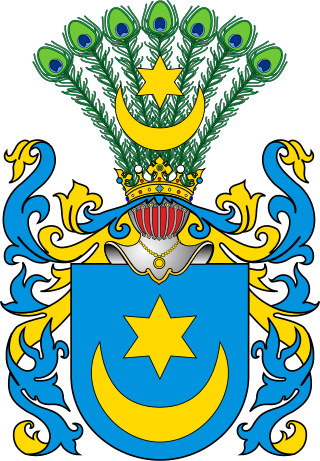| Oszyk | |
|---|---|
 | |
| Details | |
| Alternative names | Orszyk, Orszyki |
| Earliest mention | 1775 |
| Towns | none |
| Families | 1 name: Sienkiewicz |
Oszyk is a Polish coat of arms. It was used by the Sienkiewicz family.
| Oszyk | |
|---|---|
 | |
| Details | |
| Alternative names | Orszyk, Orszyki |
| Earliest mention | 1775 |
| Towns | none |
| Families | 1 name: Sienkiewicz |
Oszyk is a Polish coat of arms. It was used by the Sienkiewicz family.
| | This section is empty. You can help by adding to it. (July 2010) |
The Coat of arms of Oszyk is a Coat of arms of Łabędź variation.
Notable bearers of this coat of arms include:

Nałęcz is a Polish coat of arms. It was used by associated szlachta families in the Kingdom of Poland and the Polish–Lithuanian Commonwealth (1569–1795).

Leliwa is a Polish coat of arms. It was used by several hundred szlachta families during the existence of the Kingdom of Poland and the Polish–Lithuanian Commonwealth, and remains in use today by many of the descendants of these families. There are several forms of the arms, all of which bear the name, Leliwa, but which may be distinguished as variations of the same arms by the addition of a Roman numeral. In 19th century during a pan South-Slavic Illyrian movement heraldic term Leliwa also entered Croatian heraldry as a name for the coat of arms considered to be the oldest known symbol; Bleu celeste, a mullet of six points Or surmounted above a crescent Argent – A golden six-pointed star over a silver crescent moon on a blue shield, but also as a name for all other coats of arms that have a crescent and a mullet.

Pierzchała (Roch) is a Polish coat of arms. It was used by several szlachta families in the times of the Kingdom of Poland and the Polish–Lithuanian Commonwealth.

Aksak is a Polish coat of arms of Tatar origin. It was used by several szlachta families in the times of the Polish–Lithuanian Commonwealth.

Giejsz is a Polish coat of arms. It was used by several szlachta families.

Alabanda is a Polish nobility coat of arms, used by several szlachta families in the times of the Kingdom of Poland.

Wieniawa is a Polish coat of arms. It was used by several noble, in Polish language szlachta families in the times of medieval Poland and the Polish–Lithuanian Commonwealth.

Hozyusz is a Polish coat of arms. It was used by several szlachta families.

Późniak or Przestrzał is a Polish coat of arms.

Chodkiewicz is a Polish coat of arms. It was used by the Chodkiewicz family in the times of the Polish–Lithuanian Commonwealth. A variant of the Kościesza with the Gryf coat of arms and the notable longer family line as well as much bigger family than shown here.

Bes(Bies, Bees, Beess) is a Polish coat of arms.

Trestka is a Polish coat of arms. It was used by several szlachta families in the times of the Polish–Lithuanian Commonwealth.

Cieleski is a Polish coat of arms. It was used by several szlachta families in the times of the Polish–Lithuanian Commonwealth. A variation of the Trestka coat of arms.

Ryc is a Polish coat of arms. It was used by the Ryc and Rydz szlachta families.

Czewoja II is a Polish coat of arms. It was used by several szlachta families in the times of the Kingdom of Poland and the Polish–Lithuanian Commonwealth. A variant of the Czewoja coat of arms.

Sandrecki is a Polish coat of arms. It was used by the Sandrecki szlachta family.

Chyliński is a Polish coat of arms. It was used by several szlachta families.

Bieńkowski is a Polish coat of arms. It was used by one szlachta family in the times of the Polish–Lithuanian Commonwealth.

Konderski is a Polish coat of arms.

Bochdanowicz is a Polish coat of arms of various noble families in the Galicia region.